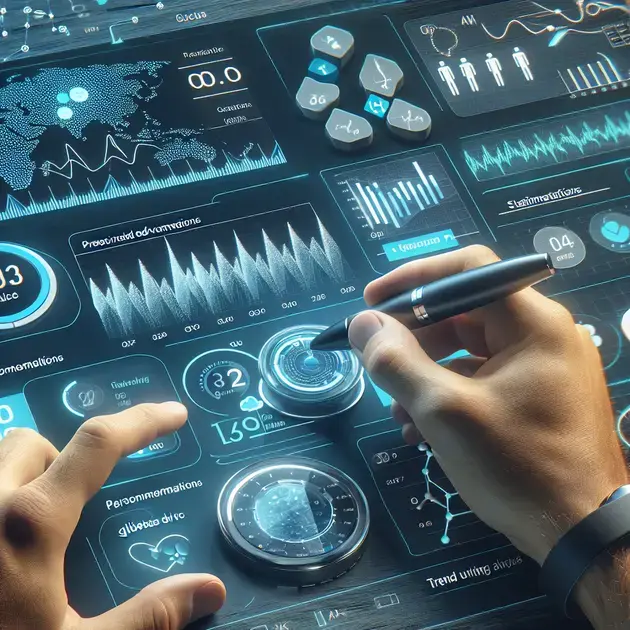Unlocking the Secrets of Average Glucose Readings
Understanding average glucose readings can be a game-changer in managing your health. Dive into this guide to decode the numbers, interpret fluctuations, and take charge of your well-being. Stay informed and empowered with expert insights and practical tips to make sense of your glucose data effectively. Let’s navigate the world of average glucose readings together and unlock the door to better health outcomes.

**Understanding Different Types of Average Glucose Readings**
When it comes to tracking blood glucose levels, understanding different types of average glucose readings is crucial for managing diabetes effectively. One popular application that provides detailed insights into average glucose readings is MySugr. By entering your blood glucose readings regularly, this app calculates your average levels over time, helping you identify patterns and make informed decisions about your lifestyle and medication adjustments.
Continuous Glucose Monitoring (CGM) devices like Dexcom G6 offer real-time data on your glucose levels, displaying trends and averages throughout the day. By using these devices and syncing them with compatible apps like Sugarmate, you can access detailed reports on your average glucose readings, enabling you to see how your levels fluctuate over different periods and in response to various factors.
Tracking average glucose readings over specific intervals, such as pre-meal, post-meal, and overnight, can provide valuable insights into how your body responds to different situations. Apps like Glucose Buddy allow you to categorize your readings and generate reports that highlight your average levels during these key times, helping you and your healthcare team tailor your diabetes management plan accordingly.
By understanding the various metrics involved in average glucose readings, such as HbA1c levels and time in range, you gain a comprehensive view of your overall blood glucose control. Utilizing tools like the Tidepool app, which integrates data from different sources like CGM devices and insulin pumps, can give you a comprehensive analysis of your average glucose readings and help you make more informed decisions about your diabetes management.
Overall, educating yourself on the different types of average glucose readings and utilizing technology-driven solutions can empower you to take control of your diabetes management and lead a healthier lifestyle.
**Factors Affecting Average Glucose Readings**
Several factors can influence your average glucose readings, making it essential to consider these variables for accurate monitoring. One key aspect to keep in mind is the timing of your meals and how they affect your blood sugar levels. Utilizing apps like mySugr, which allows you to log your meals and track their impact on your glucose readings, can help you understand how food choices influence your averages.
Exercise plays a significant role in glucose regulation, with physical activity affecting insulin sensitivity and blood sugar levels. Apps like Glooko provide features that allow you to record your exercise routines and see how they correlate with your average glucose readings. By monitoring and analyzing these patterns, you can make adjustments to your exercise regimen to optimize your blood sugar control.
Stress and emotions can also impact blood glucose levels, leading to fluctuations in your average readings. Applications such as One Drop include features for tracking stress levels and emotional well-being alongside glucose readings, enabling you to identify triggers that may affect your averages. By addressing these emotional factors, you can better manage your blood sugar levels and maintain more stable readings.
Sleep patterns and quality can affect insulin sensitivity and glucose metabolism, influencing average glucose readings. Utilizing sleep tracking apps like Sugarmate, which integrates data on your sleep habits with glucose readings, enables you to observe how rest affects your blood sugar control. By prioritizing good sleep hygiene, you can potentially improve your average glucose readings and overall diabetes management.
Medication adherence and dosage accuracy are critical factors in maintaining stable blood sugar levels and consistent average readings. Using apps like Daily+ to set medication reminders and track dosages can help you stay on top of your treatment plan and ensure that your glucose readings reflect the intended effects of your medication. Being diligent in medication management contributes to more accurate average glucose readings and better overall diabetes control.
**Tips for Accurate Interpretation of Average Glucose Readings**
When interpreting average glucose readings, it’s essential to look beyond the numbers and consider the context in which they were recorded. One useful tip is to review your readings in relation to your meals, exercise, and medication intake. Apps like GlucoseWiz allow you to input this contextual information alongside your readings, providing a more comprehensive understanding of your average glucose levels.
Comparing your average readings to target ranges set by your healthcare provider can help you gauge the effectiveness of your diabetes management. Utilizing apps like mySugr that allow you to set personalized targets and receive notifications when readings fall outside those ranges can assist you in staying on track and making necessary adjustments to maintain optimal blood sugar control.
Tracking trends in your average glucose readings over time can reveal patterns that may require intervention or lifestyle modifications. Apps such as Glucose Tracker provide visual representations of your data, making it easier to identify trends and outliers in your readings. Being proactive in addressing deviations from your target range can lead to better control of your average glucose levels and overall diabetes management.
Consulting with your healthcare team to review and interpret your average glucose readings can provide valuable insights and guidance for optimizing your diabetes care. Sharing data from apps like Tidepool or mySugr with your healthcare provider allows them to analyze your trends and offer personalized recommendations for improving your average glucose readings. Collaborating with your healthcare team ensures that you are utilizing your average glucose data effectively to make informed decisions about your diabetes management.
Regularly reviewing and analyzing your average glucose readings, in conjunction with maintaining healthy lifestyle habits and following your treatment plan, can lead to better blood sugar control and improved overall well-being. By incorporating these tips and utilizing technology-driven solutions, you can empower yourself to effectively interpret and act upon your average glucose readings for optimal diabetes management.

Different Methods to Track Average Glucose Levels
When monitoring average glucose readings, it is essential to utilize various methods to track and analyze data effectively. One common method is using a continuous glucose monitoring (CGM) system, which provides real-time data on glucose levels throughout the day. By wearing a sensor that monitors glucose levels in interstitial fluid, individuals can receive immediate feedback on their average glucose readings and detect patterns or trends.
Another method to track average glucose levels is through traditional fingerstick blood glucose monitoring. While not as continuous as CGM, this method allows individuals to take regular measurements using a blood glucose meter. By recording readings at specific times during the day, individuals can calculate their average glucose levels over time.
Some individuals may also opt for flash glucose monitoring systems, which offer a more convenient alternative to traditional CGM. With flash monitoring, users can scan a sensor to obtain real-time glucose readings without the need for regular fingersticks. This method provides a comprehensive view of average glucose readings over a specified period.
In addition to these methods, some individuals may choose to track their average glucose levels through smartphone apps or digital platforms. These tools allow users to input their glucose readings manually or sync data from CGM systems, providing an accessible way to monitor and analyze average glucose levels on the go.
Overall, utilizing different methods to track average glucose levels can help individuals gain valuable insights into their overall glycemic control and make informed decisions about their diabetes management.
Improving Consistency in Average Glucose Monitoring
Consistency is key when monitoring average glucose readings to ensure accurate and reliable data. One way to improve consistency is by establishing a routine for checking glucose levels at consistent times each day. By following a set schedule for testing, individuals can track their average glucose readings more effectively and identify patterns or fluctuations.
Another strategy to enhance consistency in average glucose monitoring is to maintain detailed records of each reading, including the time, date, and any relevant factors such as meals, exercise, or medication intake. Keeping a log of glucose data can help individuals and healthcare providers identify trends and make adjustments to treatment plans accordingly.
Furthermore, regular calibration of CGM or blood glucose meters is essential to ensure accurate readings. By calibrating devices as recommended by manufacturers, individuals can rely on the consistency and precision of their average glucose readings for better diabetes management.
When using CGM systems, it is important to properly place and secure sensors to optimize data collection and accuracy. Ensuring that sensors are correctly positioned and changed according to the device’s guidelines can contribute to more reliable average glucose monitoring results.
By implementing these strategies and maintaining consistency in tracking average glucose levels, individuals can better manage their diabetes, make informed decisions, and work towards achieving optimal glycemic control.
The Role of Technology in Analyzing Average Glucose Readings
Technology plays a crucial role in analyzing and interpreting average glucose readings, offering valuable tools and insights for individuals with diabetes. Advanced software and algorithms in CGM systems can process continuous glucose data, provide real-time analytics, and generate reports that offer comprehensive views of average glucose levels over time.
Smartphone apps and digital platforms also contribute to the analysis of average glucose readings by allowing users to visualize trends, set personalized targets, and receive notifications for high or low glucose levels. These digital tools empower individuals to take a proactive approach to managing their diabetes and making informed decisions based on their average glucose data.
Artificial intelligence (AI) and machine learning technologies are increasingly being utilized to analyze average glucose readings and predict future trends in glucose levels. By leveraging AI algorithms, healthcare providers and individuals can gain deeper insights into glycemic patterns, optimize treatment plans, and improve overall diabetes management.
Furthermore, the integration of wearable devices and smart insulin delivery systems with glucose monitoring technologies enhances the analysis of average glucose readings by providing seamless data exchange and automated adjustments based on real-time data. These integrated solutions pave the way for more personalized and precise diabetes care.
In conclusion, technology plays a pivotal role in analyzing average glucose readings, offering innovative solutions that empower individuals with diabetes to monitor their health, make informed decisions, and achieve better glycemic control.
**Conclusion**
Understanding the diverse methods available for tracking average glucose levels and utilizing technology-driven solutions are pivotal steps in effective diabetes management. By incorporating continuous glucose monitoring systems, traditional fingerstick methods, flash monitoring, and digital platforms, individuals can gain valuable insights into their glycemic control. Consistency is key for accurate monitoring, emphasizing the importance of routine testing, detailed record-keeping, device calibration, and proper sensor placement.
Technology plays a vital role in analyzing average glucose readings, enabling individuals to leverage advanced software, smartphone apps, and artificial intelligence for comprehensive data interpretation. Integrating wearable devices and smart insulin systems further enhances the precision and personalization of diabetes care. Through these innovative tools, individuals can proactively monitor their health, make informed decisions, and strive for optimal glycemic control.
Factors like meal timing, exercise, stress, sleep patterns, and medication adherence significantly influence average glucose readings, emphasizing the need for a holistic approach to diabetes management. By considering these variables and utilizing apps tailored for tracking these factors, individuals can make targeted lifestyle modifications to improve blood sugar control.
Tips for accurately interpreting average glucose readings include reviewing contextual information, setting personalized targets, tracking trends over time, and collaborating with healthcare providers. By incorporating these strategies and fostering a comprehensive understanding of their glucose data, individuals can optimize their diabetes care and enhance their overall well-being.
In conclusion, through education, technology integration, consistency in monitoring, and a holistic approach to diabetes management, individuals can empower themselves to effectively interpret and act upon their average glucose readings, ultimately leading to better blood sugar control and improved quality of life.